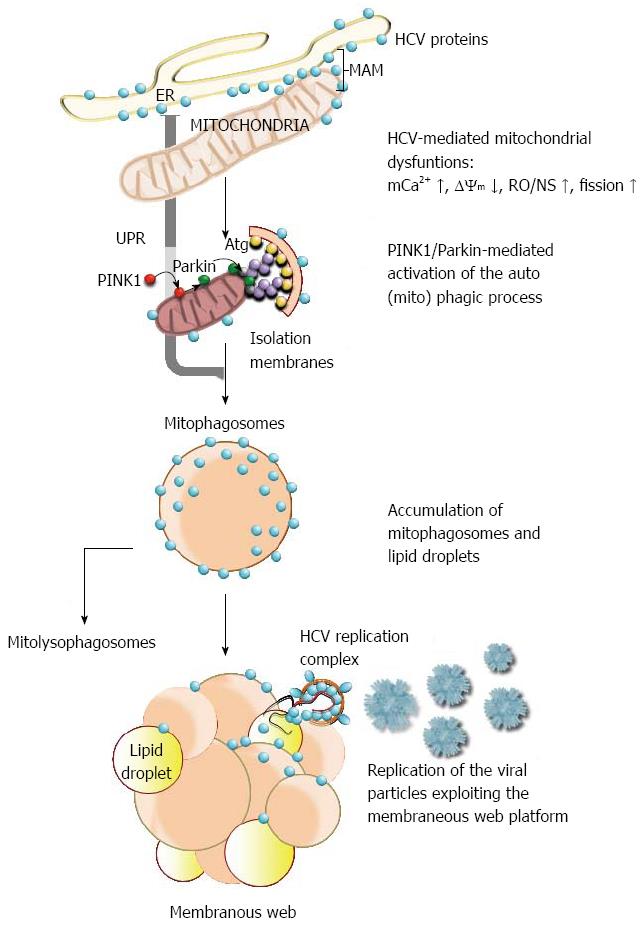Copyright
©2014 Baishideng Publishing Group Co.
World J Gastroenterol. Mar 14, 2014; 20(10): 2624-2633
Published online Mar 14, 2014. doi: 10.3748/wjg.v20.i10.2624
Published online Mar 14, 2014. doi: 10.3748/wjg.v20.i10.2624
Figure 1 Schematic representation of the hepatitis C virus-induced auto(mito)phagy in infected host cell.
The cartoon illustrates the suggested sequential steps leading to activation of the macro-autophagic process by the hepatitis C virus (HCV) proteins, which are shown as pale-blue circles localized at the endoplasmic reticulum (ER) membranes where translation and proteolytic processing of the HCV polyprotein take place. Through the mitochondria associated membranes (MAMs) the HCV proteins partly transfer to mitochondrial membranes inducing therein a number of alterations comprising enhanced influx of Ca2+, decrease of the respiratory chain activity and of the transmembrane potential, increase of reactive oxygen/nitrogen species (RO/NS), promotion of the mitochondrial network fragmentation (fission). The dysfunctional mitochondria recruit on the their outer membrane the kinase PTEN-induced putative protein kinase 1 (PINK1), which phosphorylates and activates the ubiquitin ligase Parkin. Ubiquitinated mitochondrial proteins target the organelle to the nascent macrophagic vescicles (isolation membranes) through interaction with autophagy-related gene (Atg) factors thereby leading to progressive engulfment of mitochondria in the auto(mito)phagosomes. If the rate of macrophagosomes formation overwhelms that of their degradation, via fusion with lysosomes (mitolysophagosomes), this leads to accumulation of macrophagic vesicles that combines to lipid droplets developing a membranous web. This provides a structural/functional platform where the HCV replication complex assembles and releases viral particles. Although the scheme highlights a major role of the HCV protein-mediated mitochondrial dysfunctions in the induction of the autophagic process the participation of the HCV protein-induced ER stress-mediated unfolded protein response (UPR) is also shown. See text for further explanations and references.
- Citation: Ruggieri V, Mazzoccoli C, Pazienza V, Andriulli A, Capitanio N, Piccoli C. Hepatitis C virus, mitochondria and auto/mitophagy: Exploiting a host defense mechanism. World J Gastroenterol 2014; 20(10): 2624-2633
- URL: https://www.wjgnet.com/1007-9327/full/v20/i10/2624.htm
- DOI: https://dx.doi.org/10.3748/wjg.v20.i10.2624









